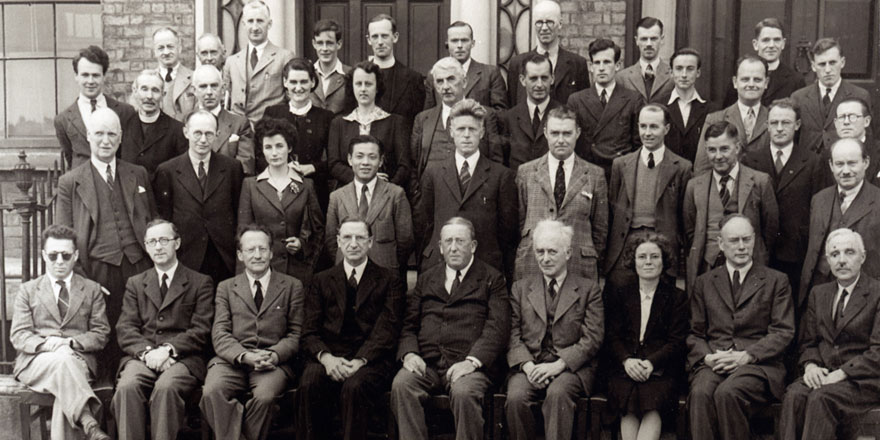
100th anniversary of the birth of Sheila Tinney, MRIA
12 January 2018We are commemorating the100th anniversary of Sheila Tinney's birth one of our first female Members on 15th January 2018.
She is celebrated as a female academic in STEM and her portrait was included in the award-winning Women on Walls campaign, in partnership with Accenture.

Shelia Tinney portrait by Vera Klute for Women on Walls
DIB Women on Walls: Sheila Tinney
Tinney, Sheila Christina (née Power) (1918–2010), mathematical physicist, was born on 15 January 1918 in Galway city, fourth daughter of Michael Power (1885–1974), professor of mathematics in UCG (1912–55), and Christina Power (née Cunniffe), who also had a son and later another daughter. Michael Power's mathematical interests included the theory of complex functions; towards the end of his career, he and his daughter were able to attend the same international mathematical colloquia. He had several roles in the governance of UCG and the NUI. A keen angler and golfer, he was captain in 1925 when Galway Golf Club raised money to buy and lay out its new course. Christina Power died in 1930, leaving a family of six children, including two sets of twins, all under 15; Sheila was 12.
Sheila Power attended the Dominican College, Taylor's Hill, Galway, and then went to St Mary's Dominican Convent, Cabra, Dublin, where she took her leaving certificate examinations in 1935. Unusually, she took honours mathematics, one of only eight girls in the country to do so, and had the highest marks in geometry and also in Latin of all Irish girls in that year. Even more unusually, Power opted to study mathematics, first in UCG for a year, then in UCD, from where she graduated BA (1938) with a first-class degree in mathematical science, and MA (1939). Her results were so outstanding that she was awarded an NUI travelling studentship prize; she went to the University of Edinburgh to work on a doctorate. Her supervisor was the celebrated physicist and mathematician Max Born; Power worked with him on the stability of crystal lattices, and was awarded a Ph.D. by Edinburgh in 1941. She is believed to be the first Irish woman to receive a doctorate in the mathematical sciences. Her first paper, based on her thesis, appeared in 1942.
In 1941 she was appointed to an assistant lectureship in UCD, at the age of 23, and also held a part-time fellowship in the Dublin Institute for Advanced Studies (DIAS). A year later, she was the only woman attending an international colloquium in the institute, at which the Nobel prize winner Paul Dirac lectured on quantum electrodynamics. This was a topic on which Power herself lectured and published several papers. She was promoted to statutory lecturer in 1945. From September 1948 to June 1949 she took leave of absence to go on a fellowship to the Institute for Advanced Study in Princeton, New Jersey, where she worked on aspects of nuclear physics. Colleagues there included Albert Einstein and Freeman Dyson. While visiting New Jersey, Power went horse riding, but was thrown off when the horse was startled by a snake; the resulting concussion was the worst injury she sustained in a lifetime of participation in sporting activities such as mountaineering and skiing.

'Formal Group outside DIAS c. 1943: Sheila Tinney in second row, third from left
Erwin Schrödinger (qv), director of DIAS, described her as among the 'best equipped and most successful of the younger generation of theoretical physicists in this country', and in 1949, on her return to Dublin, Power was one of the first four women to be elected to full membership of the RIA, along with Phyllis Clinch (qv) (a UCD colleague), Eleanor Knott (qv) and Françoise Henry (qv); she later served on the council of the academy (1975–6). After her marriage in the summer of 1952 to Sean Tinney (d. 2003), an engineer who held senior positions in the ESB, Sheila took her husband's name and became known professionally as Sheila Tinney. She retained her connection with DIAS as a research associate (1954–7), and became an associate professor in mathematical physics in UCD in 1966. However, the heavy teaching load with which Tinney coped throughout her career (she taught engineering as well as science students) meant that there was little time for new research, and probably – given that she was teaching large first-year undergraduate classes as well as postgraduates – little energy left, even for developing her existing interests.
A charming and strikingly attractive woman, Tinney was also a gifted and dedicated amateur musician; music was very important to her, as part of her heritage from her mother, and was very much a family affair. Her son Hugh Tinney became a celebrated professional pianist, and one of her two daughters, Ethna, was also a concert pianist and producer of music programmes for RTÉ. Mary Catherine Tinney (qv), Sean Tinney's sister, was an enthusiastic musician as well as one of Ireland's first women career diplomats. Sheila Tinney retired from UCD in 1978. Her husband was president of the Royal Dublin Society (1995–7), but by then Sheila Tinney was suffering from Alzheimer's disease, and she eventually had to move into a nursing home, where she spent the last nine years of her life. She died in the Molyneux Home, Dublin, on 27 March 2010.
Aberdeen Journal, 12 July 1941; Tadhg Foley (ed.), From Queen's College to National University (1999), 169–72; A century of scholarship: travelling students of the National University of Ireland (2008); Ir. Times, 26 June 2010; 'Sheila Christina Power Tinney', on MacTutor History of Mathematics, a website compiled by Edmund Robertson and John O'Connor, www-history.mcs.st-and.ac.uk/Printonly/Tinney.html (accessed Jan. 2016)



